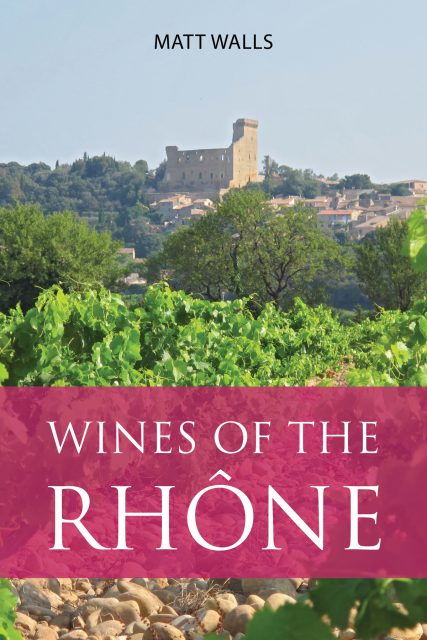This website uses cookies so that we can provide you with the best user experience possible. Cookie information is stored in your browser and performs functions such as recognising you when you return to our website and helping our team to understand which sections of the website you find most interesting and useful.
André Simon Awards shortlist extract: Wines of the Rhône by Matt Walls
The André Simon Food and Drink Book Awards have celebrated the best of contemporary food and drink writing for over 40 years. Food and drink assessors, Rose Murray Brown MW selected the shortlisted entries for the drinks category, while Nigerian-born writer and artist Yemisi Aribisala selected the food category titles.

We are running extracts of each of the books shortlisted in the drinks category of the André Simon Awards. Here is the latest, from Wines of the Rhône by Matt Walls.
Extract follows:
If you only ever visit one appellation in the Southern Rhône, let it be Gigondas, a Provençal jewel nestled amongst oaks and Aleppo pines on a western slope of the Dentelles de Montmirail. It’s only a 5-minute drive up from the D977 but suddenly you feel the altitude, a faint alpine whisper. It won’t take you long to wander around the lanes of densely-packed, slender houses or to scale the stone steps to the church at the top of the village, but it’s not something you could ever tire of. And it supplies some vital physical activity between lunch and dinner; you can eat, rest, and of course drink very well here.
This little nook has long been attractive to humans. Relics from the Bronze Age have been unearthed, and we know there was a settlement of Roman veteran soldiers here since they left so many artefacts behind. It’s not certain, but the origin of the name Gigondas may come from the Latin word jucundus, meaning ‘joyful’. Vines have certainly been cultivated at least since Roman times, and its status as one of the best Rhône terroirs is long established.
Gigondas’ first attempt to gain cru status dates back to 1948, but requests were continually turned down. The head of the INAO at the time was Baron Le Roy of Châteauneuf-du-Pape, and he was considered by locals to be a bitter opponent to its promotion. When Baron Le Roy died in 1967, Gigondas submitted another attempt, and was successful, becoming the fourth cru of the Southern Rhône in 1971 after Châteauneuf-du-Pape, Tavel and Lirac.
A combination of factors contribute to this superb terroir, but the most important, and most complex, is its soils. The most basic way to make sense of the terroir of Gigondas is to divide it into three parts: the cone, the sands, and the Dentelles. The cone (effectively the sloping terrace at the bottom of the village, known locally as Le Cône de la Font des Papes) is the largest part of the appellation. It begins at the foot of the village at around 250 metres altitude and fans out downhill to the north-west towards the Ouvèze river. It covers an area of roughly 3 square kilometres and consists of sandy clay rich in colluvial limestone scree eroded from the Dentelles and gradually transported towards the river by streams. Closer to the river is the old alluvial terrace of the Ouvèze, containing more galets, gravels and silt. These well-draining soils enjoy the sunshine all day long, and are best planted to Grenache and Mourvèdre. They give intense, deeply fruited wines that are occasionally prone to tip into jamminess and excessive potency.
Around the foot of the mountain, between the cone and the Dentelles is a belt of Miocene marine sands and sandstone. The lieu-dit Les Bosquets features this kind of soil, and Julien Brechet of Domaine des Bosquets explains that the resulting wines have particularly good acidity – not because of the soil per se, but because this terroir is shaded for much of the day by the Dentelles. This fine, free-draining sand produces wines with good finesse, gentle tannins and a surprising potential to age. The dramatic Dentelles terroir behind the village is geologically extraordinary. In the Triassic Period this was a sea, which gradually deposited deep layers of salt and gypsum. The Jurassic Period saw layer after layer of limestone and marl laid down to a depth of 8 kilometres. The Tertiary Period bore witness to extreme tectonic activity and the Nîmes Fault helped to push these layers from the horizontal up to the vertical, resulting in the resurfacing of these ancient marls and limestone soils and the upright limestone teeth we see today. These soils encourage deep root systems, help retain water, and supply abundant trace elements for healthy plant growth. They bestow a certain structure, tension and salinity to the Grenache grown here, which is accentuated by the altitude (up to 500 metres) and their typically shady north-west-facing exposure.
In the broader context of the Southern Rhône, Gigondas wines tend to be full-bodied, deeply generous, flowing wines with a fruit profile ranging from strawberry and raspberry through to damson, and occasionally darker fruits, depending on the blend. The style of the wines is tightly defined, with few stylistic outliers; you could argue the wines are too homogeneous, in fact. But the growing fashion for single-vineyard wines is helping to increase diversity. In terms of quality, Gigondas is the most consistent cru in the Southern Rhône.
Since they are based around Grenache, wines are usually approachable on release, lacking any major tannic resistance that you find in, say, young Cabernet Sauvignon or Nebbiolo. The flip side of this however is that the vast majority of Gigondas is drunk too young. The best wines tend to hit their stride 10–15 years after vintage, and continue to improve for some time. They seem to possess a natural vigour that helps them stay the course.
Gigondas still sits in the shadow of Châteauneuf in the minds of many consumers, but is rapidly building a reputation for quality thanks to a combination of factors: distinctive terroir, reliable quality, over 100 private domaines (meaning large availability and distribution), a well-funded syndicat and a dynamic leader in Louis Barruol. The latest project by the syndicat has been to plant a vineyard containing 380 genetically unique plants, all massal selection Grenache from well-adapted, virus-free, old-vine Gigondas plant material. It’s the biggest Grenache conservatory in the world, and local vignerons will be allowed to take cuttings to propagate their vineyards. This will benefit the appellation for generations to come. Gigondas has come a long way fast, and with its naturally fresh terroir, is well placed to continue this upward trajectory.
Extract from Wines of the Rhone © Matt Walls (Infinite Ideas, 2021). Shortlisted for the André Simon Food and Drink Book Awards 2021. http://www.andresimon.co.uk/
The winner of each category (food and drink) will receive £2,000 prize money. In addition, there are the John Avery and the Special Commendation awards (£1,500) granted at the discretion of the judges.


